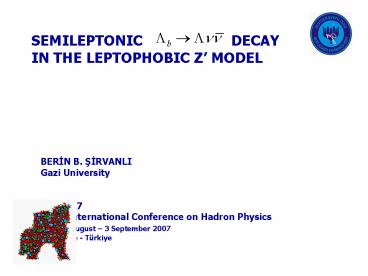SEMILEPTONIC DECAY IN THE LEPTOPHOBIC Z MODEL - PowerPoint PPT Presentation
1 / 21
Title:
SEMILEPTONIC DECAY IN THE LEPTOPHOBIC Z MODEL
Description:
SEMILEPTONIC DECAY IN THE LEPTOPHOBIC Z' MODEL. BERIN B. ... The dependence of the differential decay branching ratio as function of the momentum transfer ... – PowerPoint PPT presentation
Number of Views:49
Avg rating:3.0/5.0
Title: SEMILEPTONIC DECAY IN THE LEPTOPHOBIC Z MODEL
1
SEMILEPTONIC DECAY IN THE
LEPTOPHOBIC Z MODEL
BERIN B.
SIRVANLI Gazi University TROIA07
International Conference on Hadron Physics
30 August 3 September 2007 Çanakkale - Türkiye
2
OUTLINE
- Leptophobic Z Model
- Matrix Elements for the
Decay - Numerical Analysis
- Conclusion
3
1- LEPTOPHOBIC Z MODEL
- Z gauge bosons are proposed some models in
the SM extension . These are - E6-Model
- LR-Symmetric models
- Extra Dimensions
- 3-3-1 Model etc.
4
- The extra neutral gauge boson can be leptophobic
by introducing the kinetic mixing term in the E6-
model. - In the leptophobic model, U(1) charge is zero
for all the ordinary left and right handed lepton
fields within the SM. However, 27 representation
of E6 contain new right handed neutrino which is
absent in SM. - In Grand Unification Theory of view, a U(1)
gauge group remains as a low energy effective
theory after the symmetry breaking of the E6
group. We assume that the E6 group is broken
through the following breaking chain, - E6 ---gt SO(10) ? U(1)?
- ---gt SU(5) ? U(1)? ? U(1)?
- ---gt SU(2)L ? U(1)Y ? U(1)
- where U(1) is a linear combination of two
additional gauge group, U(1)? and U(1)?. - U(1) gauge group charge is Q Q? cos? - Q?
sin?. - ? is the E6 (?-type) mixing
angle(?tan-1(3/5)-1 37o) .
5
- The interaction Lagrangian of fermion fields
and Z gauge boson can be written as - where the ratio of gauge couplings
, - gQ and gY is the gauge couplings respectively ,
U(1) and U(1). - The general fermion Z
couplings depend on two free parameters, tan? and
?.
6
The Z gauge boson can be leptophobic when
for lepton doublet L, and
right-handed singlet ec (Lepton fields in E6
models)The Z boson can be made leptophobic
with
7
2 - MATRIX ELEMENTS FOR THE
DECAY
- The decay at quark
level is described by - transition. In the SM, effective Hamiltonian
responsible for the - transition is given by
- The effective Hamiltonian describing
transition can be written as - where
Hadronic Part
Leptonic Part
8
For the decay amplitude of the
decay in the leptophobic Z we have,
- where
- Seklinde verilir.
9
- For the form factors are given as follows,
- A1 (f1 - g1) , A2 (f2 g2)
- B1 (f1 g1) , B2 (f2 g2)
- (T.M.Aliev,M.Savci /hep-ph/0510133).
10
- We write the ? baryon spin(1/2) four vector in
terms of a unit vector along the ? baryon spin
in its rest frame, - And we choose the unit vectors along
longitudinal, transverse and normal components of
the ? polarization as
11
Differential decay rate
12
To analysis the asymmetry parameter
- When ? is unpolarized, (??0)
- When ?b is unpolarized, (??b0)
13
3- Numerical Analysis
- The value of input parameters
- Z mass limits are between
14
The dependence of the differential decay
branching ratio as function of the momentum
transfer
15
Total branching ratio as function of the
effective coupling constant in the leptophobic Z
model
16
The dependence of the longitudinal polarization
for the decay
17
The dependence of the normal polarization for the
decay
18
- The transverse component PT of the ??
polarization, - There is no interference terms between SM and
Leptophobic Z model contributions and terms
proportional to Usb involves to the BR and
polarization effects. Therefore it can not induce
CP violation.
19
The distribution of asymmetry
parameter as a function of momentum transfer .
20
- 4- CONCLUSION
- We have analysed the longitudinal,transverse and
normal polarization of ? baryon on q2 dependence. - The dependence of the branching ratio on
- is investigated and the dependence of the
polarization parameter of ?b baryon on q2
dependence is also investigated. - ?b asymmetry parameter hasnt been measured yet.
However, it can be measured in the LHC. It is a
good tool for investigate to new physics and make
test of the theoretical models.
21
- THANK YOU!































